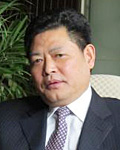|
 |
|
GRAND PROJECT: The Tang West Market in Xi'an is constructed to revive the historical West Market in the Tang Dynasty (618-907) (WEI YAO) |
 |
|
Lu Jianzhong, Board Chairman of Xi'an Tang West Market Culture Industry Investment Co. Ltd. (COURTESY OF LU JIANZHONG) | Just before noon, more and more people poured into the temple fair held at the Tang West Market, a group of ancient-style buildings in Xi'an, capital of northwest China's Shaanxi Province. It was the Lantern Festival, the conclusion of the 15-day Chinese Lunar New Year celebration and the end of the temple fair, making it the fair's most festive day.
Temple fairs are a traditional way for the Chinese to celebrate their Lunar New Year, which fell on February 3 this year. Considered one of the largest in China, the Tang West Market Temple Fair attracted about 100,000 persons every day for a fortnight. Walking through streets adorned with various lanterns and other festival ornaments, visitors found themselves surrounded by traditional art, folk performance, as well as tasty local snacks.
"The temple fair here is fantastic. It adds more festive flavor to our Spring Festival holiday," said Hang Zhijie, a local visitor. "Sugar figure-making, shadow plays and stilt walking remind us of our nation's many traditions."
Hang is among many in Xi'an who like the Tang West Market, not only because it is home to an excellent temple fair, but also because it recreates an ancient market of the Tang Dynasty (618-907), when Xi'an, then named Chang'an, was the capital of China.
Splendor
Covering more than 300,000 square meters, the magnificent Tang West Market architectural complex is located on the site of a thriving Chang'an market 1,300 years ago. The ancient market, called West Market, was three times the size of today's Tang West Market. Its temple fair was also one of the best in China at that time.
Tang Dynasty Chang'an was home to two major markets. The East Market was mainly patronized by members of the imperial family and aristocrats. The West Market, on the other hand, catered to ordinary people and was famous for foreign trade.
Tang Dynasty was a prosperous era. With a population of more than 1 million, Chang'an was one of the largest cities in the world. As the political, economic and cultural center of China, Chang'an was foreigners' favorite place. Those foreigners generally came from countries along the Silk Road, an ancient overland trade route linking Asia and Europe. Many of them brought goods from their own countries to Chang'an to be traded in the West Market, thus boosting commerce in the market. Many of the foreign merchants traded in jewelry, silk, tea, herbs and medicine.
According to archaeological discoveries, the ancient market was neatly divided into nine parts. In addition to places for foreign and local vendors to offer their goods, the market also housed restaurants, liquor stores, hotels and banks.
Trade ties between Chang'an and the countries along the Silk Road also facilitated cultural and artistic exchanges. For example, during the Tang Dynasty, music and dance from Western countries were very popular in Chang'an. It was also very common to see the locals in Chang'an wearing Western-style clothing and vice versa.
 |
|
PRECIOUS RELIC: A Tang Dynasty artifact depicting a foreign merchant riding a camel is displayed in the Tang West Market Museum (WEI YAO) |
The Silk Road first developed during the Western Han Dynasty (202 B.C.-A.D. 9). But economic and cultural ties between China and other countries along the trade route reached their peak during the Tang Dynasty. For this reason, Chang'an was widely considered the eastern end of the Silk Road, with the West Market serving as the major locus for Chang'an's booming foreign trade activities.
In 2006, the State Administration of Cultural Heritage of China noted the ancient West Market was representative of the trade along the Silk Road during the Sui (581-618) and Tang dynasties. Recently, the site of the West Market was added to the list of representative sites of the Silk Road. China, along with five Central Asian countries—Kazakhstan, Kyrgyzstan, Uzbekistan, Tajikistan and Turkmenistan—have jointly applied to have these sites inscribed on UNESCO's World Heritage List.
Preservation
The site of the original West Market was the site of archaeological excavations conducted twice in the 1950s and 1960s. Due to technical limitations, no attempts were made to preserve or rebuild the ancient buildings or conduct further archaeological research at the time.
|
